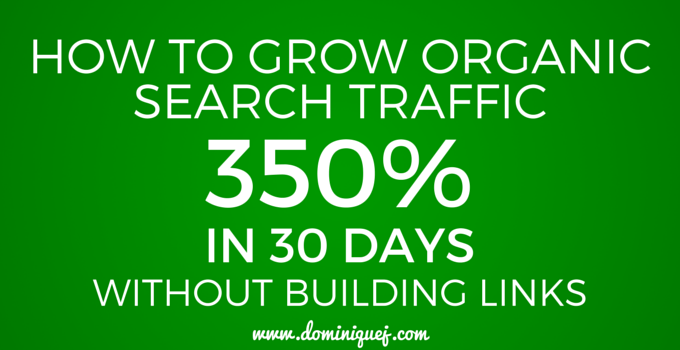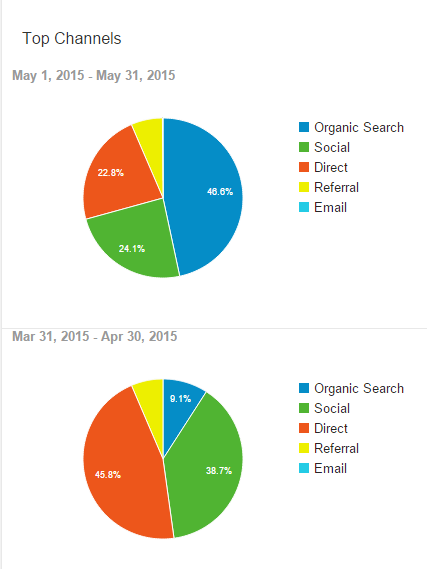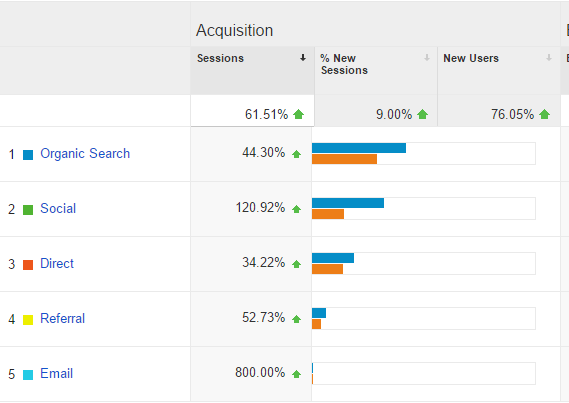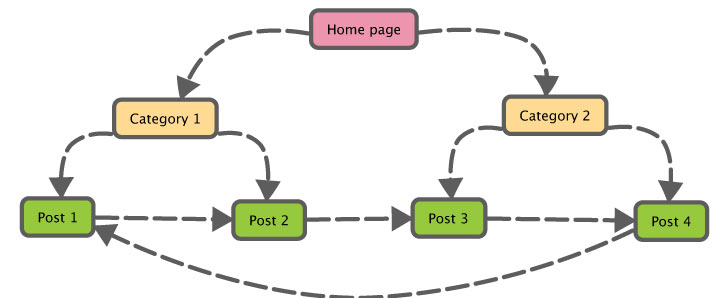During the first few months of restarting my site, a majority of my traffic was coming from social media. I was on Twitter heavy (still am), and building up a following. I was happy that I was getting traffic from social media, but the truth is that for bloggers, you should really be aiming to get as much traffic from organic searches as possible. Because social traffic is cool, but it takes a continuous effort if you want to keep it up.
But with search traffic, once your blog posts start ranking, you’ll get a pretty steady supply of traffic without having to do much to sustain it. I have one blog that I started years ago, and only added one new post to it this entire year, and it steadily gets thousands of visitors each month from organic search traffic.
Of course, there’s always the risk that an update to Google’s algorithm will destroy your rankings overnight. And that’s why it’s always a good idea to have multiple sources of traffic. I still get a good amount of traffic from social media, and over the next year or so I’m hoping to start getting more referral traffic and email marketing traffic. And that’s what you should be aiming for with your blog too – Diversity.
It’s like eating healthy. Sure you might like to get your protein from chicken. But what happens when there’s some kind of freak accident that contaminates your chicken supply? Or what if your grocery store runs out of chicken? You’re just not going to eat protein? Of course not! you’re going to pick up some fish, turkey, eggs, and whatever else you can find and diversify.
That’s the same approach you should have with your blog. If your site stops ranking in Google tomorrow, it might suck, but it shouldn’t completely ruin everything you’ve done. Just start putting more effort towards social media, email marketing, or getting guest posts. There’s plenty of ways to get traffic to your blog.
Ok, so I went on a little tangent there, but back to the main topic. From April to May of this year, my traffic from organic search grew by 352%. Social traffic, direct, and everything else went down unfortunately. But a lot of that had to do with the fact that April was when I launched my first SlideShare presentation that got featured on the home page. And then the blog post I wrote about my process for creating that presentation was published on the SlideShare blog.
And organic traffic overtook social media as my blog’s #1 source of traffic.
And guess what? My organic traffic is continuing to rise. From May to June, I saw a 44% increase in organic traffic. I actually got an overall boost in traffic in June which was pretty awesome.
And the coolest part? I did it all without actively building any backlinks to my blog. So how did I do it? By focusing on content.
Writing Consistent Blog Posts
Since the official relaunch of my site, I’ve consistently published 3 new blog posts EVERY week, no excuses. There were nights when I came home from work, cooked and ate dinner, then stayed up until 2AM to finish a blog post to go up the next day, slept a few hours and had to get up and go to work. Why? Because I made the decision that I would stick to that schedule, and I was determined to make it happen whether one person views my posts or a thousand.
[Tweet “#Blogging isn’t a sprint, it’s a marathon!”]
Here’s what happens to a lot of bloggers. You tell yourself you’ll blog 4 days a week. Then one day you’re tired so you say no big deal, I’ll just do 3 this week. Then the next week something else comes up so you only publish a couple posts a week. Next thing you know, you’ve only published a few blog posts in the entire month, then next month it’s one post, and then you’re posting once every few months until you eventually give up.
This exact same thing has happened to me before, and I didn’t want it to happen here so I made a blog schedule I was confident that I’d be able to stick to without sacrificing quality. I’m happy to say I’ve been able to stick with it for about 4 months now.
That publishing schedule helped me build up a pretty hefty supply of fresh, high quality content (over 50 articles now), which Google loves.
Key takeaway: Make a blogging schedule that you feel comfortable with and stick to it! If you ever do slip up and miss a day, pick right back up and keep going. Make blogging into a habit. Regularly publishing new posts shows Google’s search bots that your blog is active.
Writing The Right Kind Of Blog Posts
This part is probably even more important than just adding content consistently. Over the years, I’ve discovered that there are some very specific types of blog posts that tend to rank highly in Google. I’m talking about:
- Evergreen content (content that isn’t time sensitive or won’t get old like a news article)
- Content that solves a problem (i.e. how-to posts and guides)
- List posts
One of the biggest examples of how much Google favors these types of posts is Quick Sprout. That site is JAM PACKED with ultimate guides and how-to posts. Damn near every post on the site has the word “how” in it. That’s not a coincidence. Neil Patel is a PRO with SEO (awesome rhyme FTW), and he knows how powerful that type of content is when it comes to ranking blog posts.
With that in mind, I started to make sure I was incorporating these types of post into my blog. Every post might not be an ultimate guide, but you’ll notice that I’ve been striving to make content that’s more actionable and evergreen, as opposed to content that’s more theoretical and just informative.
Every now and then I’ll make a post about my opinion on something, but for the most part I’ve been sticking with content that shows you how to do/improve something, or solves a problem that bloggers have.
Here’s why this type of content rocks. Most people turn to Google when they want to find a solution to a problem they’re having. Whether it’s someone looking for weight loss tips, how to train their dog, where to eat, or how to blog better, they’re all looking for answers. These types of blog posts fill those needs, so Google prioritizes them in the search results.
I mean, think about it. Someone searching for tips on how to lose weight doesn’t necessarily want to know the physiological causes of why they’re overweight. They want to know how to lose the weight. So the search results for “how to lose weight” look like this:
Creating content that answers questions and solves problems is how you attract audiences that are more likely to take action, instead of people who just want information.
Making this type of content has definitely been one of the main reasons my search traffic has been growing so much. The two posts on my blog that get the most traffic are:
- How to embed Pinterest pins and boards on your website
- How to create an awesome SlideShare presentation
Again, it’s not a coincidence that these posts are bringing in organic search traffic. Another thing to keep in mind here is that a lot of people think that guides or evergreen content has to 3,000+ words long. But that’s not always the case. My post about embedding Pinterest pins and boards is less than 600 words. The SlideShare post is over 5,000 words long, but gets less organic search traffic. It’s not all about word count.
And guess what my #3 and #4 most popular posts are?
List posts!
It’s that simple. Google is straight up telling you what they want to see. Valuable content. And valuable content means you’re showing people how to do something (guides and how-to’s), or you’re creating some type of resource (like a list) that people can use. Sure, there’s other types of blog posts you can and should make that add value. But if you want to see feed a starving audience and increase your blog’s search traffic, then start making more evergreen content.
Key takeaway: Make sure you’re adding a ton of evergreen content like how-to guides, lists, and blog posts that solves problems and is actionable.
Internal Linking
Having a steady supply of fresh content for Google to index, and to feed my audience were some of the main reasons I decided to put out 3 blog posts a week. But another reason was because I wanted to build up a library of blog posts that I could start linking to internally.
An internal link is just a link from one page on a website to another page on the same site. Google loves internal links.
When I write blog posts, I like to link to supporting resources as much as possible. It helps me keep my blog posts on topic without going into super long, kind of unrelated tangents, which is easy for me to do (I did it in the beginning of THIS blog post). When my site only had a few blog posts, I had to link to other people’s blog posts a lot. But now that I’m starting to create more content, you’ll notice that my newer posts have a lot more internal links to my other posts.
Just look at all the internal links I have in this post. I’ve linked to at least 5 different articles. But without having a good sized supply of blog posts, it wouldn’t be possible.
If you really want to see an example of how powerful internal linking is, just head on over to every high school student’s favorite resource for writing research papers, Wikipedia. Depending on what page you land on, you can expect to see 20+ internal links to other articles on Wikipedia. That site is like an endless maze of content.
You don’t have to have 4 million+ articles on your blog like Wikipedia to put this into action. Like I said, my blog has a little over 50 articles on it right now, and I’m able to add internal links to all of my posts.
Here’s a tip to start adding more internal links to your blog posts. Whenever you link to someone else’s blog in one of your post, write a similar article of your own. Then, you’ll be able to replace the external link to the other person’s blog with your own.
Don’t get me wrong. Linking out to other sites is also good for your blog’s SEO, and I still do it a lot. But you should be making an effort to link to more of your own content when you can.
[alert-note]Check out my post on how to add internal links in WordPress in seconds![/alert-note]
Key takeaway: Start building up a library of blog posts on your site so you can build internal links in your articles. All of your blog posts should have at least one or two internal links to supporting blog posts. A healthy mix of internal and external links will help boost your SEO.
Editing Old Posts
This is something that I haven’t done yet, but I plan on doing from now on. Even though I’ve been writing for years, and I’m happy with the quality of the content I put out, there’s always room for improvement. That’s why I plan on going back through some of my old articles from time to time and seeing if anything can be improved.
Whether it’s adding more content, changing the headings, adding more images, or putting in some internal links. Giving your old posts a facelift can help with SEO, and breathe new air into posts that might be outdated and, well… stale.
I’m not going to go through EVERY post and update them just because it might help with my blog’s ranking. There’d be no point in trying to “revive” a post like this. That’s a waste of time. I’m going to go back and look at some of the posts I wrote that I really like, but maybe didn’t get as much attention as they could’ve because they weren’t well optimized, or didn’t have as much content as I probably could’ve put in.
Key takeaway: You have to set your ego aside. Go back and look at some of your old blog posts that are are good, but not getting as much organic search traffic as they probably could. See if there’s any changes you can make to the content that might help bring it back to life.
Start Growing Your Blog’s Organic Traffic!
That’s all I did.
- Published blog posts consistently
- Wrote blog posts that solve problems, and is evergreen
- Built internal links like a mofo
I fully expect my blog’s organic traffic to keep on growing because I put a lot of focus on content and on-page SEO. Getting backlinks is definitely important to help your blog get more SEO traffic, but don’t get it twisted. It all comes back to what people see when they finally land on your blog.
Start putting these tips into action, focus on your content, and you’re going to start noticing that your organic traffic picks up….. wait for it….. ORGANICALLY!










![How To Get More Twitter Followers With The Follow Back Technique [Case Study] How To Get More Twitter Followers With The Follow Back Technique [Case Study]](https://dominiquej.com/wp-content/uploads/2015/06/Twitter-Follow-Back-Case-Study.png)
Great post Dominique! I have edited some of my old posts by adding images, slideshows, infographics etc. and that has helped boost it’s overall quality.
Thanks Priyanka! That’s good to hear.
Internal links are a must! This is one of the items that I wish new bloggers would focus on. When I figured it out organic search went through the roof. Great article!
Thanks Steven! Yup, internal links are a very powerful, but underutilized aspect of on-page SEO. There’s actually a few different WP plugins that help make building internal links even easier for larger sites.
My blog is mostly opinions maybe that’s why not too much organic traffic.
Yea it’s a lot easier to get organic traffic if your content is informational rather than just a personal blog.
The internal linking part reminds me of a post I had in a blog I owned – and later sold. It wasn’t a mega post (less than 900 words) compared to some posts I wrote that were 2000 words. This post was my most popular and with the links I added in it to my other articles (and subscribe page), visitors stayed longer and read more posts. And I liked that. I bet you do too, yes?
Yup, that’s one of the best parts about internal linking. Thanks for checking it out Philos!
the old How To posts, good reminder, I’ll write one for my blog today and see how that goes. Thanks for the content
Awesome, go for it Corey!
I really enjoy reading your articles. I learn a lot. More power!
Awesome, glad you like them Jen!